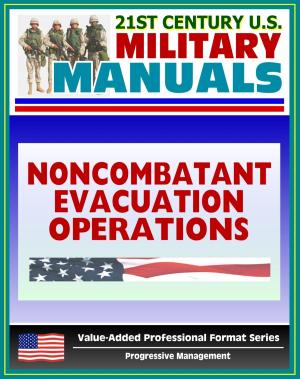Planning for Action: Campaign Concepts and Tools - Wargaming, Clausewitz, Iraq, Petraeus, Afghanistan, Tommy Franks, Dr. Strange, War Against Terrorism, Hurricane Katrina, Post 9/11
Nonfiction, History, Military, United States| Author: | Progressive Management | ISBN: | 9781311305572 |
| Publisher: | Progressive Management | Publication: | May 7, 2014 |
| Imprint: | Smashwords Edition | Language: | English |
| Author: | Progressive Management |
| ISBN: | 9781311305572 |
| Publisher: | Progressive Management |
| Publication: | May 7, 2014 |
| Imprint: | Smashwords Edition |
| Language: | English |
The purpose for this book is straightforward: to provide an overview of planning principles and the tools used by planners to design campaign plans. Since 9/11, the US military has been involved in numerous actions, most notably in Iraq and Afghanistan. The approach to campaign planning has changed and evolved over this time, spawning a number of new concepts and approaches to planning; this book is intended to provide some assistance in understanding and applying those concepts and approaches. A campaign is defined as "a series of related major operations aimed at achieving strategic and operational objectives within a given time and space." That's a fairly broad definition for a campaign - but campaigns are normally joint operations (which means it is conducted by more than one service of the US military) and relates directly to strategic level or national objectives. Put another way, campaigns are fought because the US President has decided that our national level objectives necessitate the commitment of US military forces.
Planning for Action: Campaign Concepts and Tools is designed to be used as a handbook for developing campaign plans at the US Army Command and General Staff College. This book provides working definitions of campaign concepts and tactics, techniques, and procedures (TTPs) for campaign planners. In order to support the concepts, there are a number of "thinking tools" that complement and reinforce our operations process with a rational, logical approach to an increasingly complex and dynamic operational environment. Linking the campaign planning concepts to the thinking tools enables commanders to implement the mission command imperatives of understand, visualize, and describe to create a shared understanding of the problem and the operational approach to transform conditions to meet national objectives. Although all of the concepts and TTPs in this handbook are based on joint and US Army doctrine, they represent a way to approach campaign planning rather than the way that must be followed. Doctrine provides a "starting point" with common definitions and a common frame of reference - but doctrine requires original applications that adapt it to circumstances. As with doctrine, the concepts and tools described in this book also require judgment in application. The intent is to provide a starting point for developing campaigns with particular emphasis on ensuring unity of purpose in planning and executing campaigns.
PART I: Planning for Action Concepts * Chapter 1: Problem Solving * Chapter 2: Ends, Ways, and Means * Chapter 3: Understand * Chapter 4: Visualize * Chapter 5: Describe * Chapter 6: Exercising Collaborative Leadership * Chapter 7: Framing and Reframing * Chapter 8: Developing the Narrative * PART II: Planning for Action Tools * Chapter 9: Centers of Gravity * Chapter 10: Developing Distinct Courses of Action * Chapter 11: Lines of Effort * Chapter 12: Critical Factor Analysis (CC-CR-CV) * Chapter 13: Target Value Analysis * Chapter 14: Wargaming * Chapter 15: Assessment (MOE and MOP) * Chapter 16: Parting Thoughts * Appendix A: General Ridgway in Korea * Appendix B: Examples
The purpose for this book is straightforward: to provide an overview of planning principles and the tools used by planners to design campaign plans. Since 9/11, the US military has been involved in numerous actions, most notably in Iraq and Afghanistan. The approach to campaign planning has changed and evolved over this time, spawning a number of new concepts and approaches to planning; this book is intended to provide some assistance in understanding and applying those concepts and approaches. A campaign is defined as "a series of related major operations aimed at achieving strategic and operational objectives within a given time and space." That's a fairly broad definition for a campaign - but campaigns are normally joint operations (which means it is conducted by more than one service of the US military) and relates directly to strategic level or national objectives. Put another way, campaigns are fought because the US President has decided that our national level objectives necessitate the commitment of US military forces.
Planning for Action: Campaign Concepts and Tools is designed to be used as a handbook for developing campaign plans at the US Army Command and General Staff College. This book provides working definitions of campaign concepts and tactics, techniques, and procedures (TTPs) for campaign planners. In order to support the concepts, there are a number of "thinking tools" that complement and reinforce our operations process with a rational, logical approach to an increasingly complex and dynamic operational environment. Linking the campaign planning concepts to the thinking tools enables commanders to implement the mission command imperatives of understand, visualize, and describe to create a shared understanding of the problem and the operational approach to transform conditions to meet national objectives. Although all of the concepts and TTPs in this handbook are based on joint and US Army doctrine, they represent a way to approach campaign planning rather than the way that must be followed. Doctrine provides a "starting point" with common definitions and a common frame of reference - but doctrine requires original applications that adapt it to circumstances. As with doctrine, the concepts and tools described in this book also require judgment in application. The intent is to provide a starting point for developing campaigns with particular emphasis on ensuring unity of purpose in planning and executing campaigns.
PART I: Planning for Action Concepts * Chapter 1: Problem Solving * Chapter 2: Ends, Ways, and Means * Chapter 3: Understand * Chapter 4: Visualize * Chapter 5: Describe * Chapter 6: Exercising Collaborative Leadership * Chapter 7: Framing and Reframing * Chapter 8: Developing the Narrative * PART II: Planning for Action Tools * Chapter 9: Centers of Gravity * Chapter 10: Developing Distinct Courses of Action * Chapter 11: Lines of Effort * Chapter 12: Critical Factor Analysis (CC-CR-CV) * Chapter 13: Target Value Analysis * Chapter 14: Wargaming * Chapter 15: Assessment (MOE and MOP) * Chapter 16: Parting Thoughts * Appendix A: General Ridgway in Korea * Appendix B: Examples















